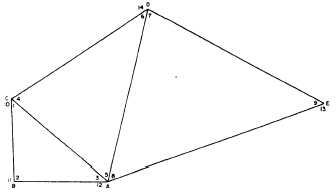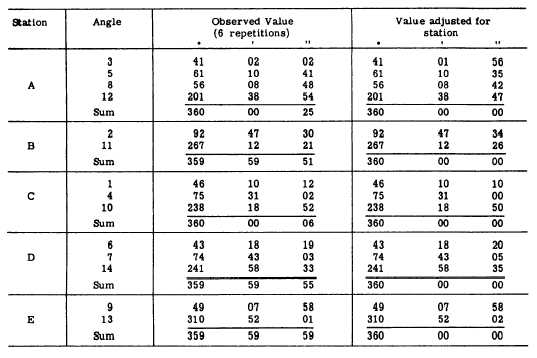applied), as corrected for temperature and for slope. For
the interval between stakes 5 and 6 (where there is, as
you can see, a forward set), the horizontal distance
amounts to the standard tape length plus 0.104 foot, as
corrected for temperature and for slope. The length of
the base line will, of course, amount to the sum of the
horizontal distances.
Note that in this case the line is being measured
forward. After the forward measurement, the line is
again measured in the backward direction. If the
backward measurement varies slightly from the
forward measurement, the average is taken as the
length of the base line. A large discrepancy would, of
course, indicate a mistake in one measurement or the
other.
Rather than using chaining operations to perform
base line measurements, an electronic distance meter
(EDM) can be used. The use of EDM equipment greatly
simplifies the measurement of base lines in
triangulation. Chapter 12 of this TRAMAN gives a
general discussion of EDMs and EDM principles.
Computations
In triangulation of ordinary precision or higher, the
observed angles are adjusted before the lengths of the
triangle sides are computed. The most rigorous and
accurate of adjustment methods is the least squares
method that involves the computation of the most
probable values of the adjusted quantities. In many
advanced surveying textbooks, the least squares method
Figure 15-27.—-Chain of triangles.
is preferred; however, calculation of the probable values
of the unknowns involves a level of mathematics
(calculus) that is beyond that required of the
Engineering Aid. Therefore, in this text we will discuss
more elementary adjustment procedures that, while less
accurate than the method of least squares, yield
satisfactory results.
There are two steps in angle adjustment, called
station adjustment and figure adjustment. Station
adjustment applies the fact that the sum of the angles
around a point is 360°. Figure adjustment applies the
fact that the sum of the interior angles of a polygon is
(n – 2) x 180°, with n representing the number of sides
of the polygon.
ADJUSTING A CHAIN OF TRIANGLES.— In
station adjustment you compute the sum of the
Table 15-6.—Station Adjustment for Chain of Triangles, Figure 15-27
15-34




